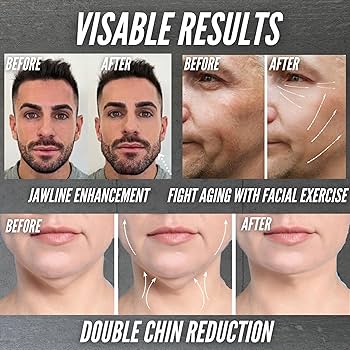Have you ever wondered if chewing gum could give you a more defined, toned face? It sounds simple—just chew gum regularly and watch your jawline become sharper.
But can something as easy as chewing really shape your facial muscles and enhance your appearance? You’re not alone in asking this question. Many people hope that this small habit might lead to noticeable changes without intense workouts or expensive treatments.
Before you start popping gum all day, it’s important to understand what really happens to your facial muscles and if chewing gum is a safe and effective way to tone your face. Keep reading to discover the surprising truth behind this popular idea—and what experts say about it.
:max_bytes(150000):strip_icc()/chewing-muscles-2000-ffa0eee911c549bcb777b9582ca4ccf5.jpg)
Credit: www.eatingwell.com
Jaw Muscles And Chewing
The jaw muscles play a key role in chewing and facial movement. Chewing gum activates these muscles with each bite. This constant action can make the jaw muscles work harder than usual.
Understanding how these muscles function helps us see if chewing gum can tone the face. The main muscle involved in chewing is called the masseter. It is one of the strongest muscles in the body based on its size.
Role Of Masseter Muscles
The masseter muscles are located at the sides of the jaw. They connect the lower jawbone to the cheekbone. Their main job is to close the jaw during chewing and biting.
Strong masseter muscles help with powerful chewing. These muscles also shape the jawline’s appearance. Larger masseter muscles can make the jaw look more defined.
Chewing gum repeatedly engages these muscles. This can increase their size and strength slightly. Still, genetics and bone structure mostly decide jaw shape.
How Chewing Works The Jaw
Chewing moves the jaw up and down, and side to side. This movement activates the masseter and other smaller muscles. These muscles work in pairs to control chewing motions.
Chewing gum forces the jaw muscles to contract often. This exercise can help maintain muscle tone. But it does not change facial fat or bone structure.
Too much chewing can cause jaw soreness or disorders like TMJ. Moderation is important to avoid these issues. Chewing gum is a mild workout for jaw muscles, not a facial toning solution.
Effects On Facial Appearance
Chewing gum moves the muscles in your face, especially around the jaw. This activity can make these muscles work more than usual. Some believe this action can change how the face looks. The real effects on facial appearance are more complex than just muscle movement.
Muscle Strength Vs. Face Shape
Chewing gum can increase the strength of jaw muscles. Stronger muscles might feel firmer to the touch. But muscle strength alone does not change the overall face shape. The bones and fat under the skin mostly decide the face’s look. Muscle size changes are usually small and not very visible.
Genetics And Bone Structure
The shape of your face comes from your genes and bone structure. These factors set the basic outline of your cheeks, jaw, and chin. No amount of chewing gum will change these hard features. A square jaw or high cheekbones are inherited traits. Muscle exercise cannot reshape the bones beneath your skin.
Health Risks Of Excessive Chewing
Chewing gum might seem harmless, but too much can cause health problems. Excessive chewing strains your facial muscles and jaw joints. This can lead to discomfort and long-term issues. Understanding these risks helps you avoid damage while enjoying gum in moderation.
Jaw Pain And Tmj Disorders
Chewing gum for long periods can cause jaw pain. The jaw muscles get tired and sore from overuse. This may lead to temporomandibular joint (TMJ) disorders. TMJ affects the joint connecting your jaw to your skull. Symptoms include pain, clicking sounds, and difficulty opening your mouth. Persistent chewing worsens these symptoms. It can even cause headaches and ear pain. Resting your jaw helps reduce the risk of TMJ problems.
Dental Issues
Chewing gum often, especially sugary types, harms your teeth. Sugar feeds bacteria that cause tooth decay and cavities. Constant chewing also wears down tooth enamel. This makes teeth sensitive and prone to damage. Some gums contain acids that erode enamel faster. Chewing gum excessively can lead to gum irritation too. Choosing sugar-free gum and limiting chewing time protects your dental health.

Credit: www.healthline.com
Scientific Evidence And Myths
Many people believe chewing gum can tone facial muscles and shape the jawline. This idea sounds simple and appealing. But what does science say? Separating facts from myths helps us understand if chewing gum truly changes our face.
Research Findings
Studies show chewing gum activates the masseter muscles in the jaw. These muscles get a small workout from constant chewing. Yet, this exercise is mild and does not build significant muscle mass. Changes in muscle size are minimal and often not visible.
Research also highlights that facial shape mainly depends on bone structure, fat, and genetics. Chewing gum does not reduce facial fat or reshape bones. It cannot sculpt or tone the face like exercise tones the body.
Experts warn that excessive chewing can cause jaw pain and issues like temporomandibular joint (TMJ) disorder. Overuse may even damage teeth. Therefore, chewing gum for long hours is not a safe method for facial toning.
Common Misconceptions
One myth claims chewing gum sculpts a chiseled jawline. This idea comes from the notion that chewing strengthens jaw muscles like weightlifting tones body muscles. The truth is, facial muscles react differently and do not grow noticeably from chewing.
Another misconception is that chewing gum burns face fat. Fat loss occurs through overall body fat reduction, not by chewing. Spot reduction of fat in the face by chewing is unsupported by science.
Some believe chewing gum can replace skincare or facial exercises. These methods target skin elasticity and muscle tone more effectively than chewing gum.
Alternatives For Facial Toning
Chewing gum alone does not effectively tone facial muscles or change facial shape. For those seeking a firmer, more sculpted look, other methods offer better results. Alternatives for facial toning include exercises targeting specific muscles and professional treatments designed to improve muscle tone and skin elasticity.
Facial Exercises
Facial exercises involve movements that engage muscles in the cheeks, jaw, and forehead. These exercises can help improve muscle strength and promote blood flow. Simple routines like cheek lifts, jaw stretches, and lip pulls can be done daily. Consistency is key to seeing gradual improvements in muscle tone.
These exercises are natural and cost-free. They work best when combined with a healthy lifestyle. Facial exercises can also help reduce tension and improve facial symmetry over time.
Professional Treatments
Professional treatments include therapies such as facial massage, microcurrent therapy, and radiofrequency skin tightening. These treatments stimulate collagen production and enhance muscle tone. They provide more visible and faster results than exercises alone.
Consult a licensed specialist to choose the best option for your skin type and goals. Professional treatments often require several sessions for optimal outcomes. They are safe when performed by trained experts and can complement daily facial exercises.

Credit: www.amazon.com
Frequently Asked Questions
What Muscles Does Chewing Gum Workout?
Chewing gum mainly works the masseter muscles in the jaw. These muscles control chewing and jaw movement.
How Long Should You Chew Gum To Get A Better Jawline?
Chew gum for 15-20 minutes daily to mildly exercise jaw muscles. Avoid excessive chewing to prevent jaw pain or TMJ issues.
Does Chewing Gum Tone Facial Muscles Effectively?
Chewing gum exercises jaw muscles but does not significantly tone or reshape facial muscles.
Which Facial Muscles Are Worked By Chewing Gum?
Chewing mainly works the masseter muscles located in the jaw area.
Can Chewing Gum Improve My Jawline Appearance?
Chewing gum alone cannot change bone structure or reduce facial fat to improve jawline.
How Long Should I Chew Gum To See Muscle Changes?
No set time; chewing gum does not produce noticeable facial muscle changes.
Conclusion
Chewing gum works your jaw muscles but won’t change your face shape. Genetics and bone structure mostly decide your facial look. Overdoing gum chewing can cause jaw pain or tooth problems. Safe and effective facial toning needs more than just chewing gum.
Consult a professional for advice on improving your facial appearance. Simple habits and exercises might help more than chewing gum alone.
 Skip to content
Skip to content 